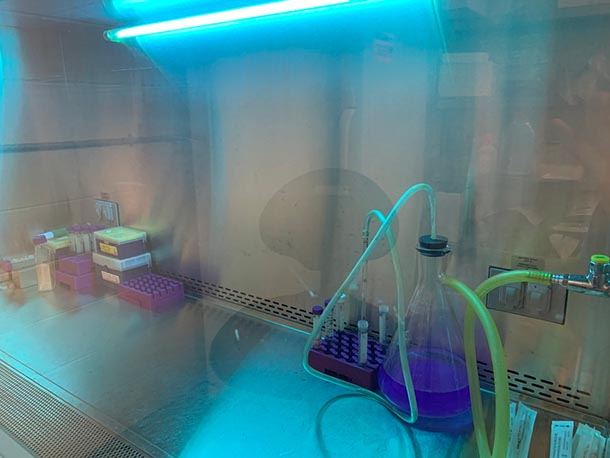May 28 2020
Commercial buildings and hospitals will have to sanitize large indoor environments now and in the coming months to inhibit the transmission of viruses such as SARS-CoV-2, which causes COVID-19.
 Ultraviolet light kills any remaining bacteria once the hood is turned off, keeping the workspace clean when not in use. Ultraviolet light might be useful to destroy virus and bacteria in other situations. Image Credit: Alyssa Lagrange, Mary Baldwin College.
Ultraviolet light kills any remaining bacteria once the hood is turned off, keeping the workspace clean when not in use. Ultraviolet light might be useful to destroy virus and bacteria in other situations. Image Credit: Alyssa Lagrange, Mary Baldwin College.
A new study funded by a seed grant could offer the knowledge base required to create optical radiation products that can be used for such large-scale sanitation processes.
William Bahnfleth, co-principal investigator and professor of architectural engineering at Penn State, has collaborated with co-PI Suresh Kuchipudi, who is a clinical professor of veterinary and biomedical sciences in Penn State’s College of Agricultural Sciences, to investigate the applicability of optical radiation to disinfect surfaces and minimize the transmission of viruses.
Bahnfleth and his colleagues were awarded seed funds worth around $90,000 for the six-month project from Penn State’s Huck Institutes of the Life Sciences, College of Engineering and the Institutes of Energy and the Environment.
Certain wavelengths of ultraviolet light have the ability to inactivate microorganisms, like fungi and viruses, by damaging their DNA or RNA so that they can no longer reproduce. Our research question for this project asks how well different wavelengths work to deactivate, or kill, coronaviruses like COVID-19.
William Bahnfleth, Co-Principal Investigator and Professor of Architectural Engineering, Penn State University
Bahnfleth, Kuchipudi, and collaborator Jim Freihaut, who is a professor of architectural engineering at Penn State, will measure the degree of disinfection of coronavirus samples within a cabinet-like reactor upon exposure to ultraviolet light with wavelengths of 254 or 365 nm for different periods of exposure.
A surrogate human coronavirus similar to the COVID-19 virus will be used by the researchers in their tests. The surrogate coronavirus will be offered by the Penn State Department of Veterinary and Biomedical Sciences. The testing will be carried out in a Biosafety Level 2 laboratory at Penn State University Park.
When best-practice ultraviolet levels and exposure times are determined, ultraviolet-based disinfection devices can then be designed to deactivate airborne viruses in building air supply systems, room or equipment surfaces, facial masks and virus sampling equipment.
Jim Freihaut, Professor of Architectural Engineering, Penn State University
Freihaut continued, “The same technology could be used, going forward, to also deactivate bacteria and other types of viruses, but the levels of ultraviolet light may need to be adjusted for each specific target contaminant.”
Eventually, stakeholders could use the same capabilities in the HVAC systems of conference rooms and schools, which are major hotbeds for the spread of all types of flu viruses, added Freihaut.
The second phase of the project will see Penn State’s Donghyun Rim, assistant professor of architectural engineering, and Richard Mistrick, associate professor of architectural engineering, collaborate with Bahnfleth to apply the results of the study’s experimental part to computational fluid dynamics modeling and lighting simulations.
The simulations will be helpful to estimate the effect of the germicidal irradiation system in combination with filtration and ventilation efforts on the practicability of coronavirus samples.
We will develop a plan to control different elements that go into the spatial model, as well as the infection risk that moves around the air distribution space. We also will model the typical air motion of a room, which is usually removed, cleaned and then recirculated in a space.
Donghyun Rim, Assistant Professor of Architectural Engineering, Penn State University
Merging the test data from the reactor system and the simulations, the researchers will then compare the ultraviolet sensitivity factors to those that have been reported in the literature for other virus types such as the polio-causing virus or the H1N1 flu virus, according to Freihaut.
Bahnfleth emphasized the practical component of this study, or what will make it useful for future consumers and building developers. With successful findings, a lamp could be manufactured that has both germicidal and lighting elements, where the germicidal element could be switched off and on as easily as engaging a light switch.
“This is 100-year-old technology, but it has only had moderate penetration outside of specialized markets like health care,” added Bahnfleth. “However, many are now realizing it is a technology that has potential to protect people in many types of buildings from the SARS-CoV-2 virus that causes COVID-19 and other dangerous pathogens.”
According to Sez Atamturktur, Harry and Arlene Schell Professor and Head of the Department of Architectural Engineering, new studies in the field of architectural engineering—similar to the one Bahnfleth, Freihaut, Rim, and Mistrick are pursuing—are essential to re-shape the future of building construction and design approaches in the near future.
“This research can serve to expedite the return back to shared building spaces like offices,” noted Atamturktur.